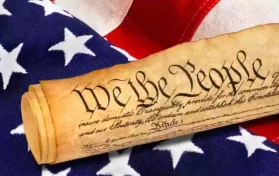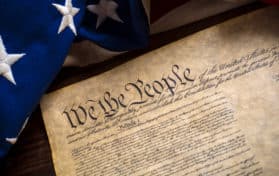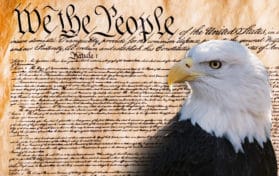
The President of the United States of America is largely referred to as the leader of the free world.
The holder of the office is viewed to have an enormous weight of responsibility on their shoulders.
The extent to which the President can exercise their powers is outlined in the Constitution of the United States of America.
The Presidency of the United States falls in the executive arm of the government. The head of the office (the President) is elected once every four years.
The Electoral College elects the President. The President has many powers and duties to discharge. So,
Who has more power than the President?
The President, the head of the Executive, holds only as much power as the legislature and the Judiciary.
This is enshrined under the United States Constitution through Separation of Powers and Checks and Balances. The President holds appointment powers over judges of the Supreme Court.
Powers And Duties Of The President
The office of the presidency derives its powers from the Constitution of the United States. These powers are discharged within the limits of the Constitution and are checked by both the Judiciary and the legislature. The powers of the President include:
1. Power to sign legislation
Once a bill has gone through Congress and been approved, the President ascends to it before becoming a law.
The President, in this case, can leave his remarks before signing a bill into law. The bill should be signed ten days after the President receives it.
2. Power to veto legislation
If the President is opposed to particular legislation, they may decline to sign it into law. This bill is usually returned to Congress for amendments.
A pocket veto occurs where the President receives a bill and refuses to ascend to it without issuing any remarks on the matter.
A presidential veto does not necessarily mean that a bill will fail to become a law. Congress can issue a veto if the President refuses to ascend to the bill, thereby effectively making it a law. It is known as a congressional veto.
3. Commander in Chief of the armed forces
The President of the United States is the Commander in Chief of the: Coast Guard, Air Force, Marine Corps, Army, Navy, and the Space Force. The President is also the Commander in Chief of the Federalized Militia.
Being the Commander in Chief means that the President can authorize nuclear strikes, supervise the military, and approve personnel deployment.
Note that the President does not have the power to declare war. The power to declare war is solely vested in Congress.
4. Convene Congress and adjourn Congress
Under extenuating circumstances, the President of the United States of America can summon both houses. It might be done to address an urgent issue or to seek the prioritization of a specific issue.
As they see fit, the President may adjourn Congress and set a new time to reconvene. It is usually done where there seems to be a “deadlock” in Congress over specific issues.
5. Issue presidential pardons
The Constitution of the United States gives a sitting president the power of executive clemency. Clemency is forgiveness that a president issues to members of the public for an acknowledged crime.
The person guilty of the crime has to submit an official application to be granted a presidential pardon.
There are two scenarios where a presidential pardon can be denied. That is, if the felon fails to acknowledge any wrongdoing or if the person filing for clemency has been found guilty to have committed a military crime.
6. Implementing and enforcing laws
Once bills are signed into law, it is the responsibility of the executive to implement them.
7. Appointment power
The President has been mandated by the Constitution of the United States of America to appoint various officials into federal offices.
Some of the members that the President appoints include all ambassadors of the United States, tenured Judges to serve in the Supreme Court, ministers, and members of the cabinet.
Presidential appointees have to be vetted and approved by the Senate. They also give advice and recommendation on matters of appointment.
8. Emergency powers
These are powers that the President exercises during times of emergency. An example was when Abraham Lincoln overturned a congressional vote and exercised executive powers to go to war. The interpretation of Emergency powers can be quite controversial.
Limitations Of The Powers Of The President
Though the President of the United States enjoys many powers, there are certain limitations to the extent to which he can exercise them. As provided by the Constitution of the United States, these limitations are:
1. Declaration of war
The President of the United States cannot declare war on any nation or kingdom. The powers to declare war can only be exercised by law through a special resolution of Congress. A special resolution requires two-thirds congressional approval.
The President still remains the Commander in Chief of the armed forces.
2. Limitations of nomination into federal office
The President has the power to make appointments in various federal offices. These nominations, however, must be approved by the Senate. The Senate has the right to dismiss any appointments if they have sufficient reasons to do so.
3. Interpret laws
The President cannot interpret the laws of the land. The power to interpret legislation is vested in the Judiciary.
How The Judiciary Checks The President
As stated earlier, checks and balances are vital as they allow the branches of the government to hold each other accountable.
The Judiciary is independent of the executive. Even though the United States president appoints the Supreme Court’s judges, these positions are tenured.
The Judiciary checks the powers of the President by determining the constitutionality of their decisions.
The Judiciary may reject executive orders if they contravene the Constitution. Similarly, the Judiciary has the authority to reject all bills passed through Congress if they are unconstitutional.
No other authority, even the office of the President, can interpret laws.
How The Legislature Checks The President
Just like the Judiciary, the legislature also checks the powers of the executive. There are several ways through which this happens. They include:
Exercising Congressional veto power
The legislature can reject any presidential veto or pocket veto concerning legislation. If the President vetoes a particular law, a special resolution by Congress can overturn the veto.
Impeachment power
The President of the United States can be ousted from office through impeachment. The power to impeach a sitting president lies in Congress. Congress is responsible for ensuring that the President does not abuse the office.
Federal Spending
Congress decides upon bills that approve the guidelines on federal expenditure. The treasury cannot draw or table bills regarding expenditure, commonly known as money bills. By approving the guidelines on expenditure, the legislature effectively checks the executive.
Impeachment And The Impeachment Process
The Constitution of the United States has vested the powers of impeachment on Congress. There are specific procedures that must be followed during the trials.
There are three steps to be followed during the impeachment process of a sitting president. They are:
Investigation:
An investigation is the first step in the impeachment process. Congress usually does this. A special committee may be set up to conduct such an investigation.
A house judiciary committee usually conducts the investigations. They can also be carried out by an independent committee appointed by the House of Representatives.
Voting by the house:
The House of Representatives votes the articles of impeachment. These articles contain the rules or terms of office that the President is said to have violated. The process only requires a simple majority, that is, a 50%+1 vote. If the simple majority threshold is realized, the President is impeached.
Trial:
In this stage, members of the Senate try the sitting President. The Chief Justice, who is the head of the Judiciary, will take over the proceedings in the Senate.
The President will vacate office if the Senate finds them guilty. It requires a special resolution. If less than two-thirds of the senate members find the accused guilty, then the accused will continue serving in the office.
Any person impeached by the Senate of the United States is deemed illegible to occupy any federal office going forward.
Conclusion
The President of the United States has powers granted by the Constitution. The Constitution further provides a separation of powers that limits the extent to which the President can enforce their will.
The United States Congress has the power to impeach a sitting president. There are checks and balances in place that limit the influence of the President on other branches of the government.
These checks and balances also prevent both the Judiciary and the legislature from interfering with the powers of the executive branch of the government.





